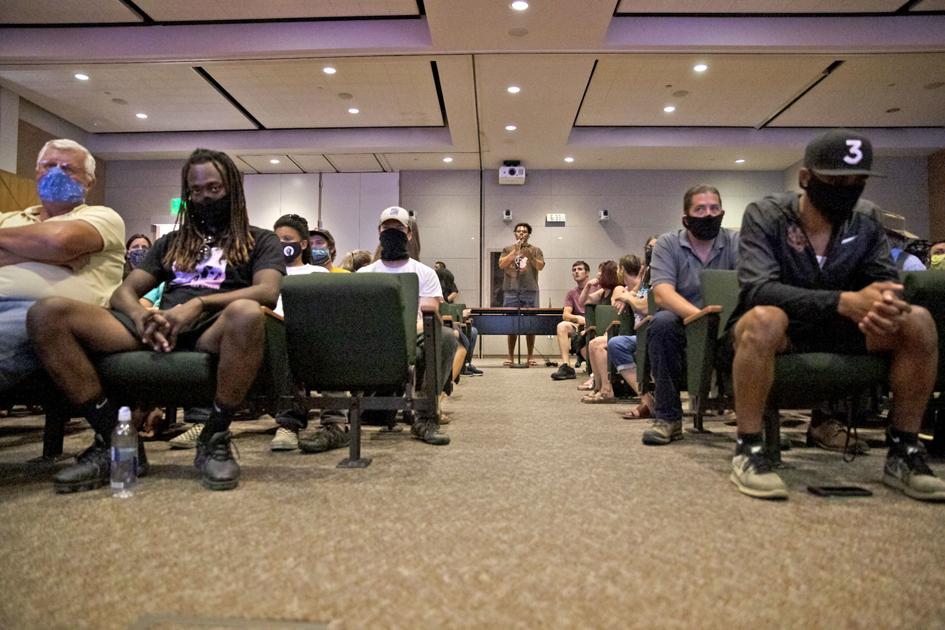israelob.blogspot.com
George Floyd was killed while detained by Minneapolis police officers on May 25 and video of his death sparked an unprecedented national response, including here in Mesa County.
Just in the last decade, black men and women dying at the hands of police have prompted outcry and protests, but the outrage from Floyd’s death, as well as the death of 26-year-old emergency medical technician Breonna Taylor at the hands of Louisville police, carried from the spring to summer, and from fall into the winter.
A June meeting of the Grand Junction City Council, the first since Floyd’s death, drew hundreds to City Hall after rallies were organized and a march held through downtown. The meeting included a call for action from several members of the Black community who spoke about their experiences with racism in Mesa County.
Many spoke to issues in the wider community, including the use of slurs and bullying at District 51 schools, issues with athletes being punished for protesting at Colorado Mesa University and other racial issues.
One of the requests made during the meeting was for city leadership and police to march with the protesters at a future rally to show unity.
Among the first city officials to publicly acknowledge his outrage when he watched video of Floyd’s death was Grand Junction Chief of Police Doug Shoemaker, who sent a series of tweets out days after Floyd’s death.
“The death of George Floyd is shocking and absolutely could have been prevented,” Shoemaker said in the series of nine tweets. “We as a profession never should be treating anyone like this. The ex-officer involved should be treated like anyone else and the delay in the pursuit of justice is far beyond concerning and baffling to me.”
Vigils and marches
Throughout the late spring and summer, many in the Grand Junction community came together with candlelight vigils, rallies and marches, including one that went to the Grand Junction Police police station and others to City Council meetings.
That first City Council meeting in June would lead to controversy later on stemming from a City Council work session. At the end of a lengthy work session on other issues, council discussion grew tense when members began to relitigate the events of the June 3 meeting. The exchange culminated in Council Member Phillip Pe’a saying he was alarmed by the number of protesters at City Hall and “didn’t know whether to bring my Glock with me in the building or not.”
Pe’a would later apologize for the comments and the council would discuss civility during discussions.
Hundreds attended that first candlelight vigil, with more watching live on Facebook.
A new organization was started to bring attention to racial issues in the area. Right and Wrong (RAW), an anti-racism coalition based in Grand Junction, hosted a Juneteenth education and celebration event at Lincoln Park for more than two hours.
It was the start of a highly visible and progressive movement for RAW throughout the summer.
TENSIONS RISE
Racial tensions were similarly high at the June 18 City Council meetings where a back-and-forth between opposing groups culminated in heated and profane discourse and one man being escorted from the meeting after criticizing the activists.
In July, several billboards around the city gave thanks to four council members but left out the remaining members.
The billboard ads were purchased by Western Colorado Business Alliance.
A member of the alliance, Michael Anton, resigned from the organization after he made remarks criticizing RAW and Black Lives Matter at the Aug. 5 council meeting.
“This RAW. This BLM. They need to go away,” Anton said at the meeting. “They’re not Grand Junction and you need to send them down the road because, believe me, there’s a lot more of me here in this valley than there is of you. I guarantee it and it will not be a pretty day if that comes forth.”
Around the same time, Grand Junction and Colorado Mesa University were forced to grapple with the complicated history of one of its most lauded historical figures, Walter Walker, a man who has a statue on Main Street, but was also responsible for bringing the Ku Klux Klan to the city. Eventually he turned against the KKK, but his affiliation created a difficult situation with the growing racial tension.
Ultimately, CMU decided to remove Walker’s name from Walker Field — the college’s soccer and lacrosse field. That decision was made by the CMU Board of Trustees in June after holding discussions with a group of students, alumni and staff.
CMU leaders involved
In fact, CMU campus leaders, including football coach Tremaine Jackson and Coordinator of Student Diversity Ky Oday, participated in the creation of the Turning the Corner on Racism task force, which is helping with the name change effort.
A similar task force was formed by the City of Grand Junction to address systemic bias in the Grand Valley with a focus on areas such as education and law enforcement. Representatives from more than 20 local organizations — from the Grand Junction City Council to the Mesa County Sheriff’s Office, as well as groups representing the homeless, faith communities, the Black and Hispanic populations and others — came together to form the task force.
Colorado Attorney General Phil Weiser stopped by the Grand Valley over the summer and met with local law enforcement and students at Colorado Mesa University during this time and shared his thoughts on ways to address police training. He felt Grand Valley law enforcement had a good grasp on why there is so much anti-police sentiment.
REFORM BILLS
By the end of June, the state passed a sweeping police reform bill, Senate Bill 20-217, which will require among other things for all Colorado law enforcement officers to wear body-worn cameras by July 1, 2023, with few exceptions.
One of the bills sponsors, Leslie Herod, D-Denver, said in a written response to the Daily Sentinel that while she was glad to hear Shoemaker’s response to what occurred in Minnesota on May 25, “the sad reality of this issue is that this behavior is not unique to Minnesota. Police misuse of force and abuse of power is an issue right here in our own state of Colorado.”
While many across Mesa County joined in the protests and rallies throughout the summer, there were some in the community that disagreed with the movement.
When members of RAW met with Gov. Jared Polis, anti-Polis protesters gathered outside the Mesa County Central Services where they got into a heated argument with activists. It would not be the last time the two sides would clash.
All through the rallies, protests, marches and counter-protests, and at times harsh words from both sides, there was never a time when the situation was out of control. The summer came and went peacefully with no incidents of violence.
Let's block ads! (Why?)
"discourse" - Google News
December 31, 2020 at 02:15PM
https://ift.tt/383vQq2
Mesa County joins national discourse on race - The Grand Junction Daily Sentinel
"discourse" - Google News
https://ift.tt/2KZL2bm
https://ift.tt/2z7DUH4





